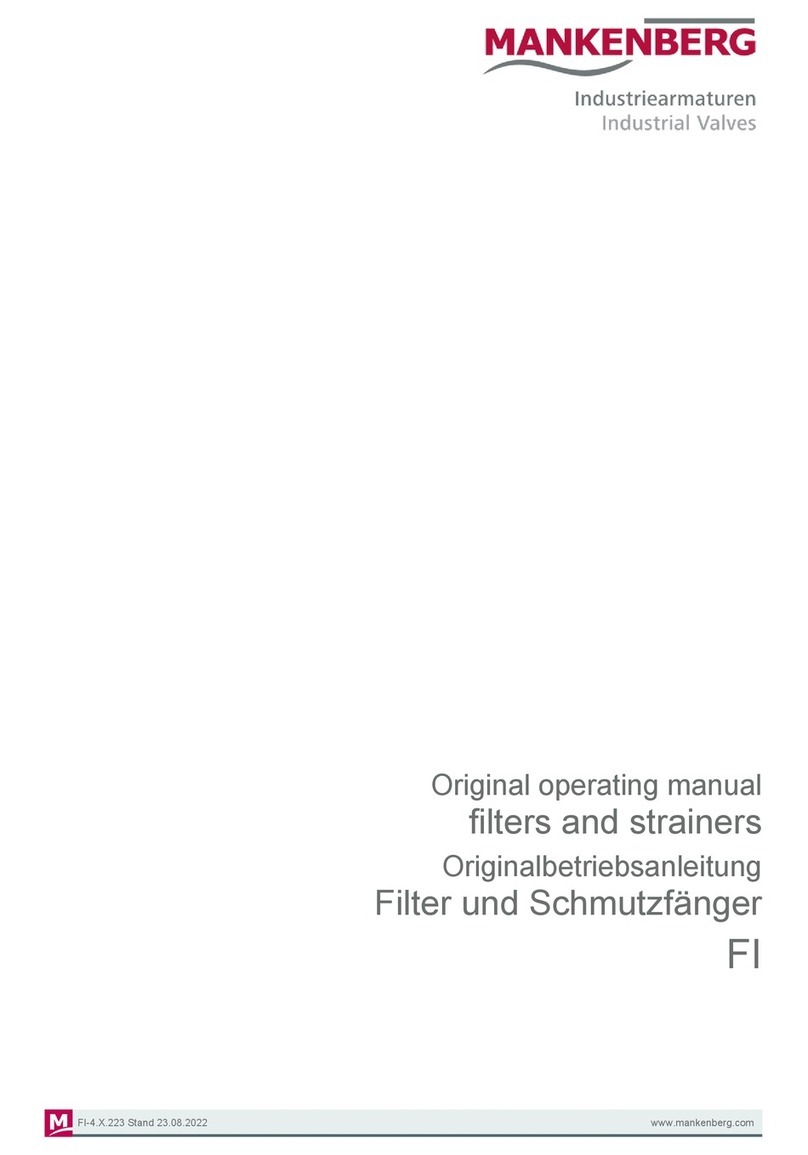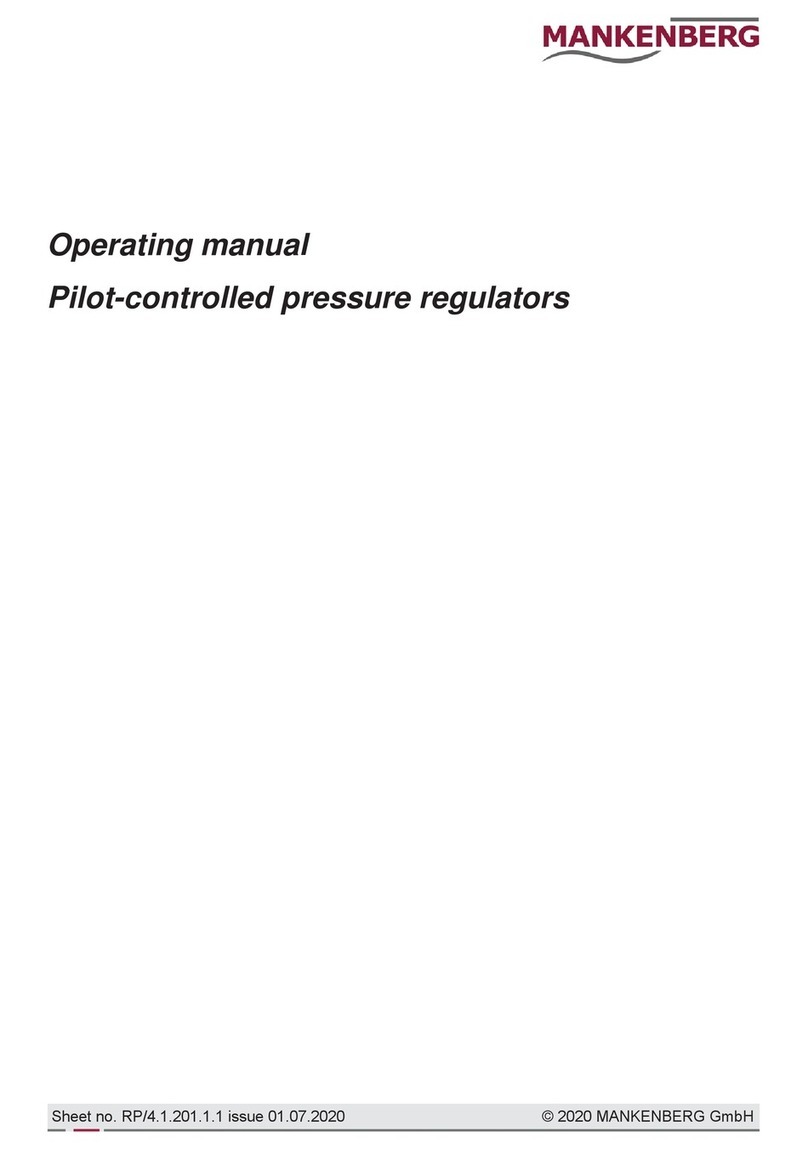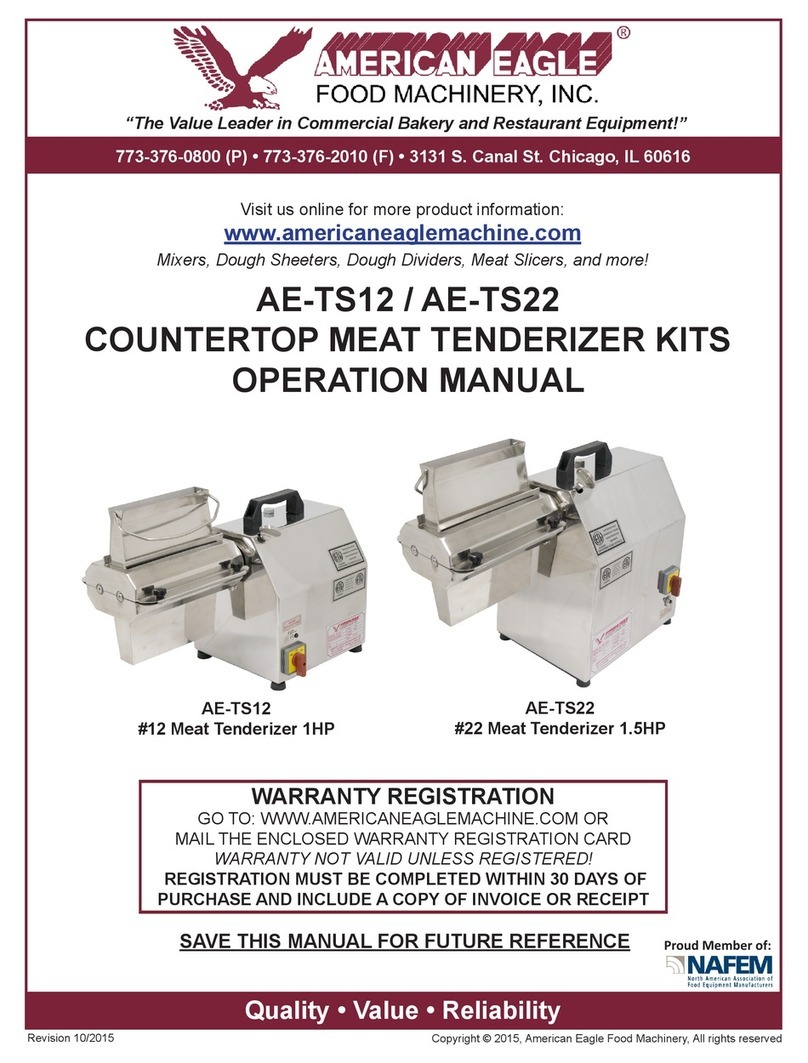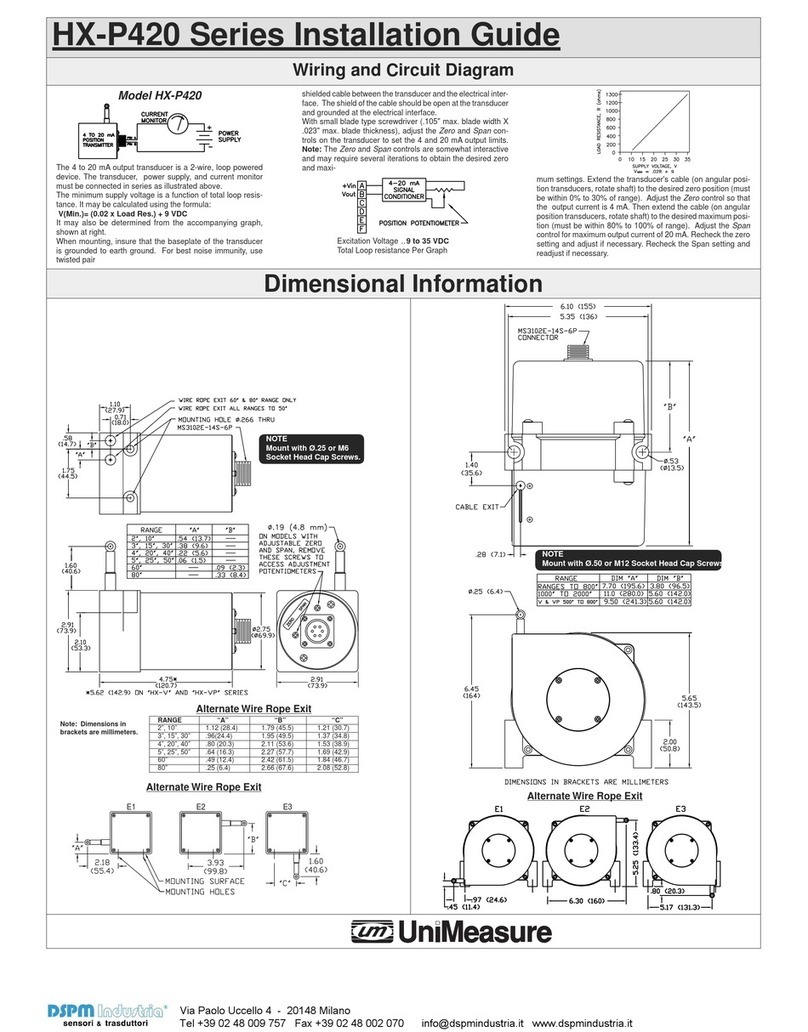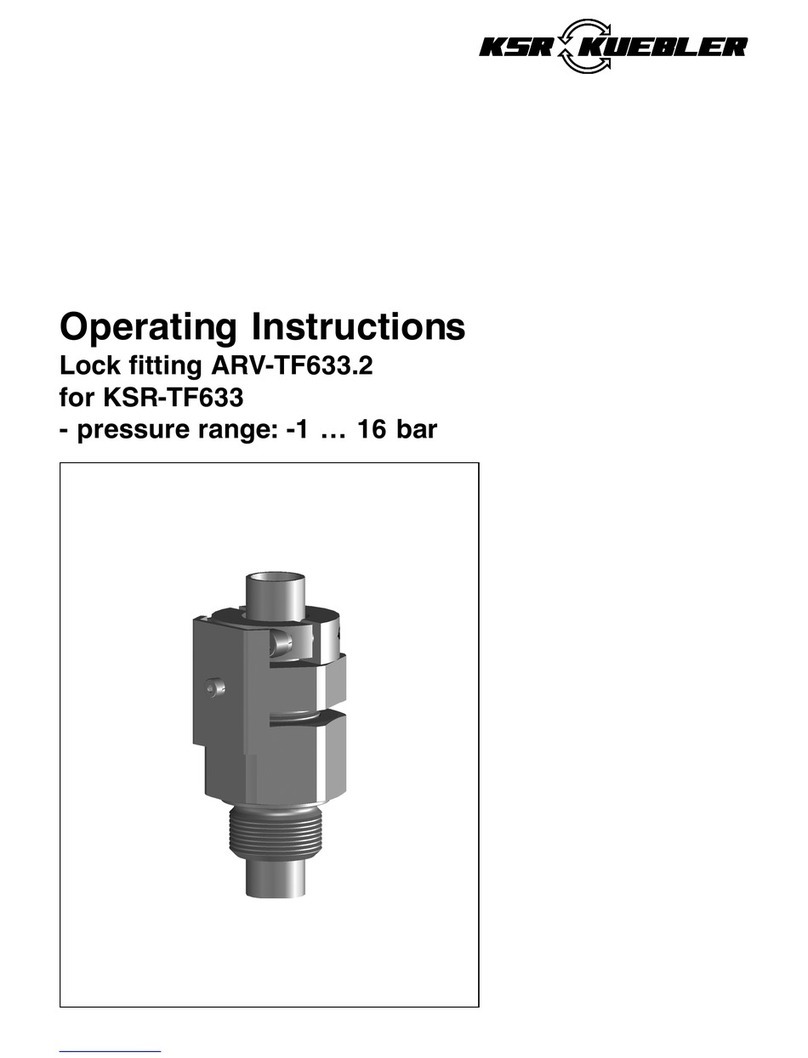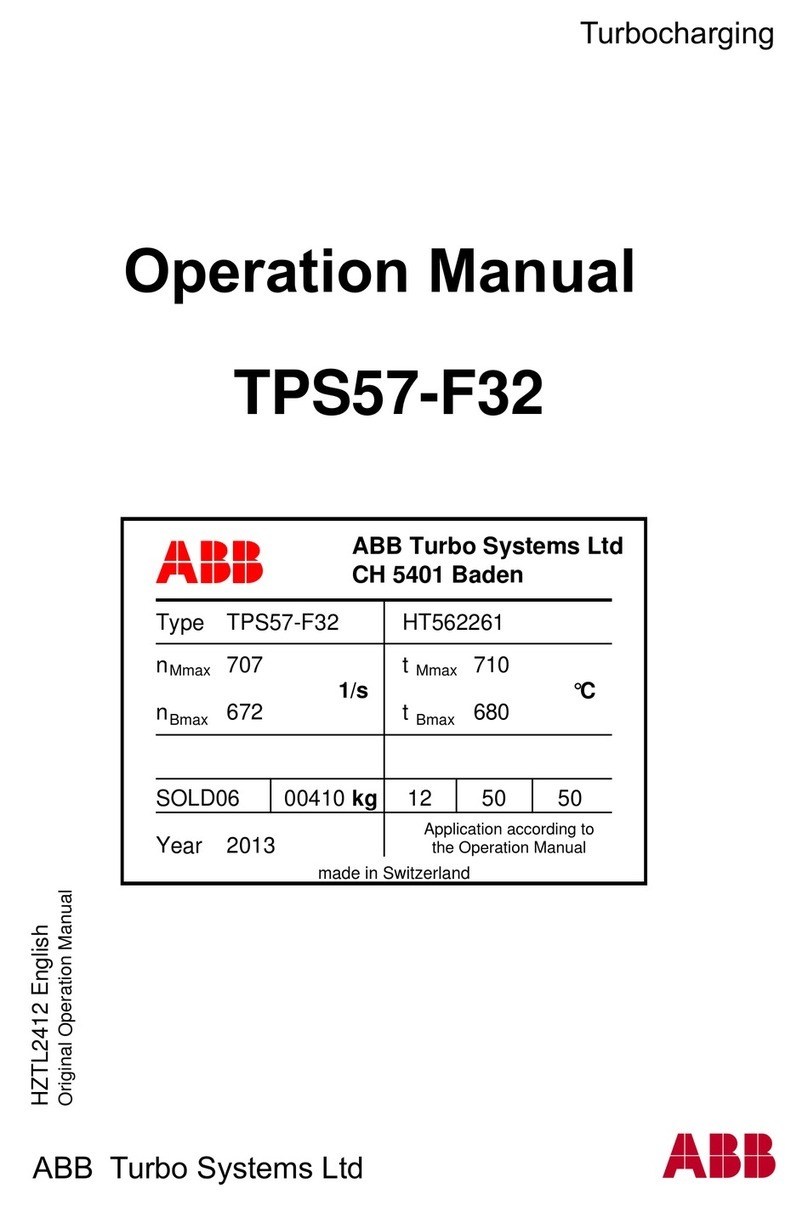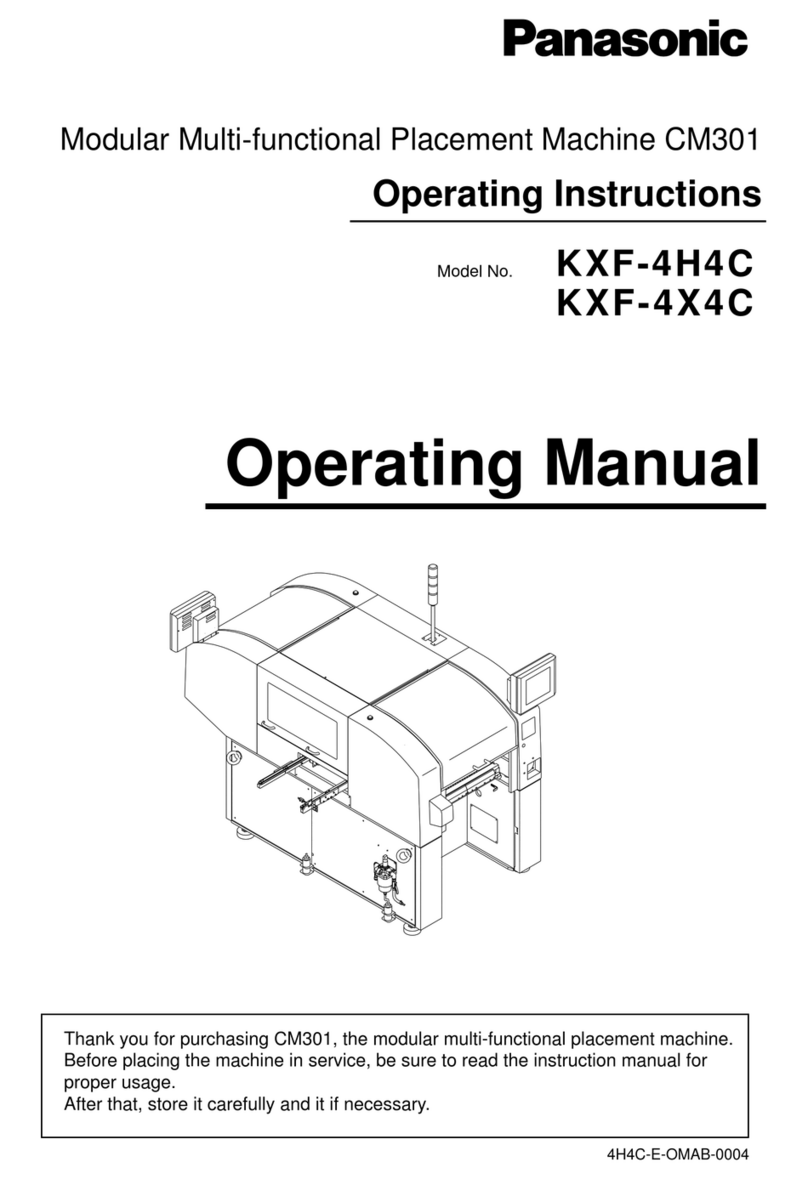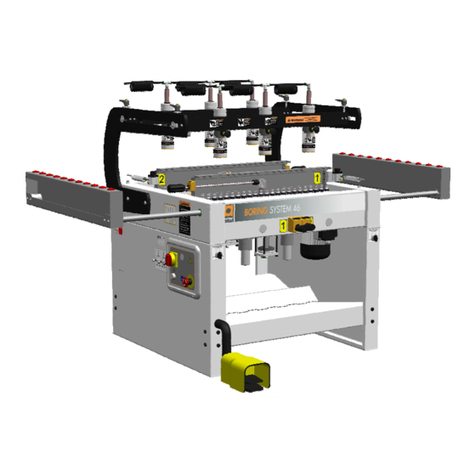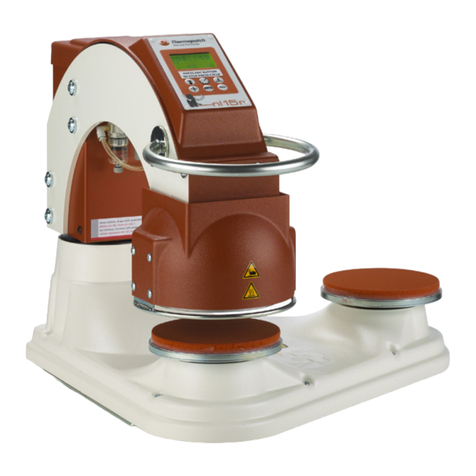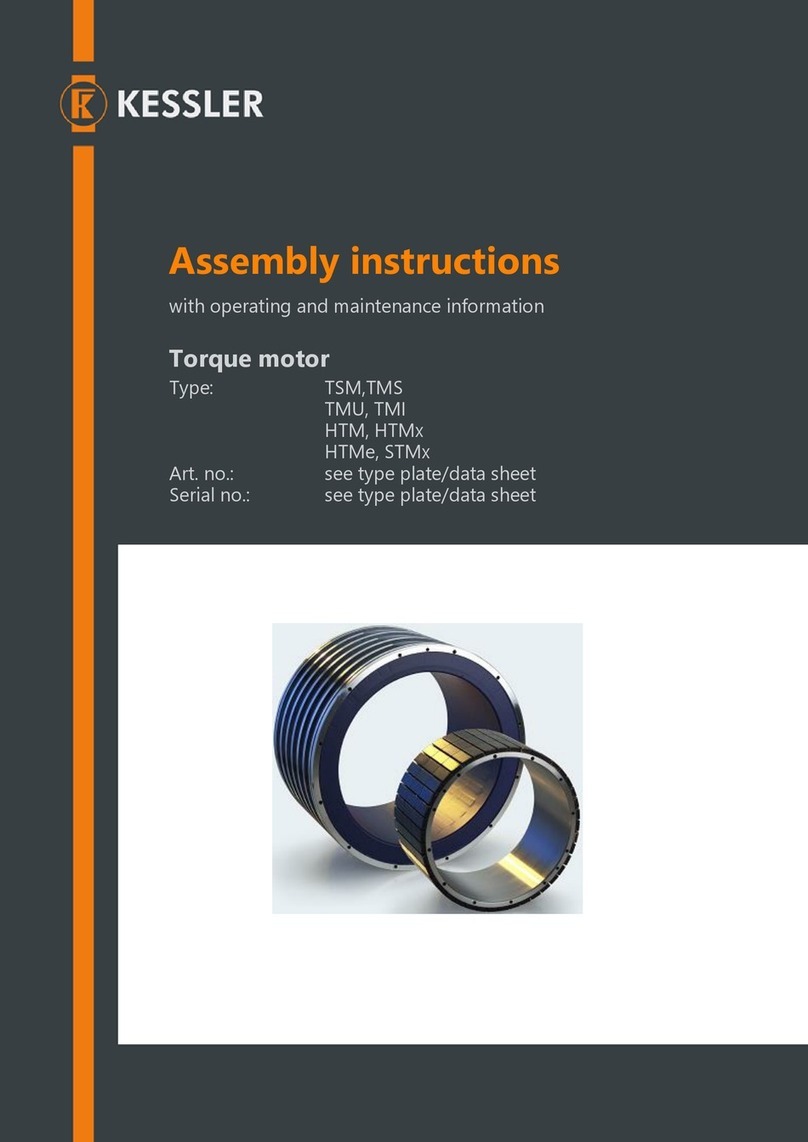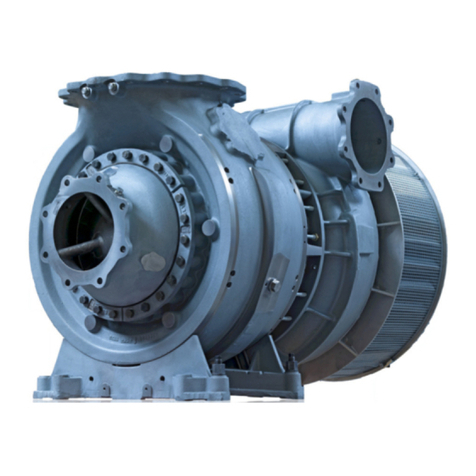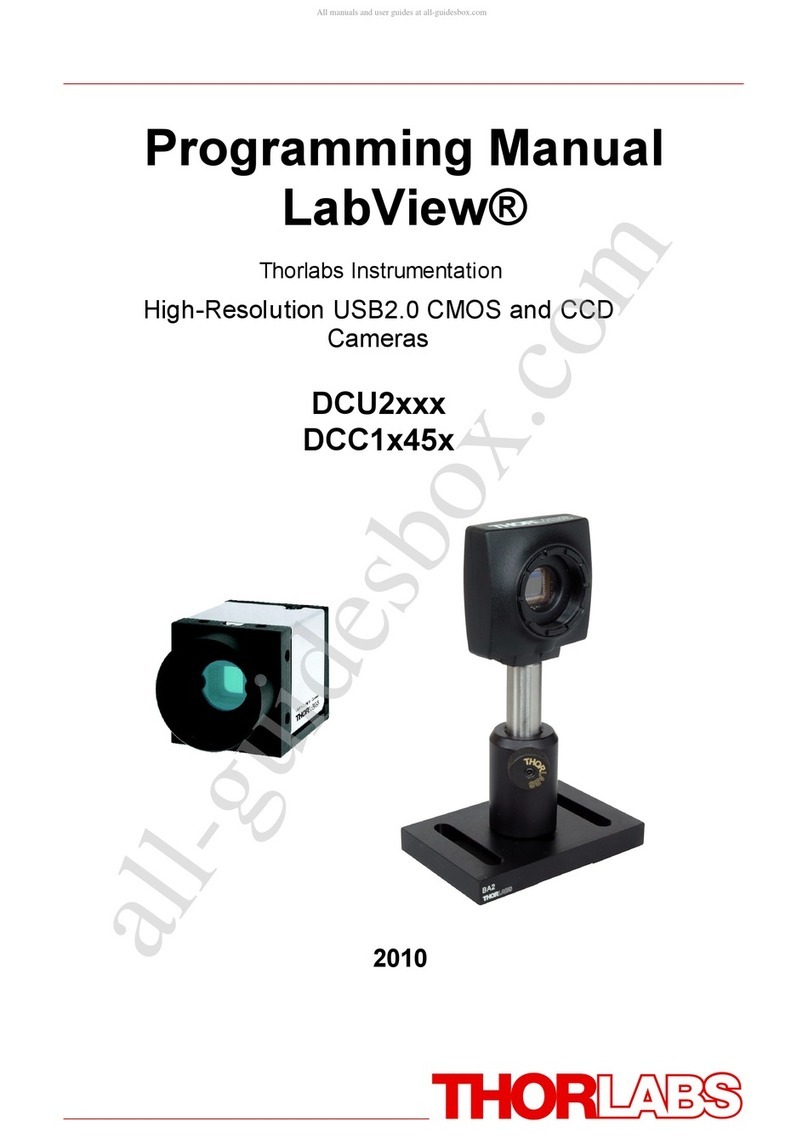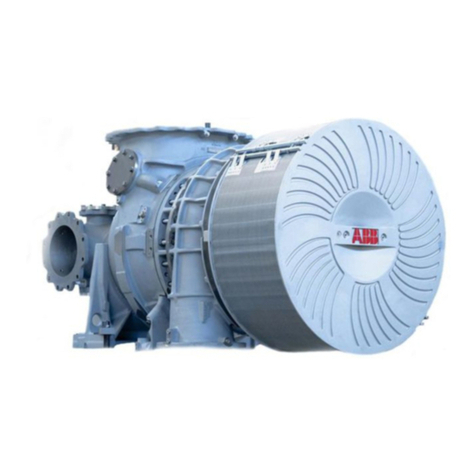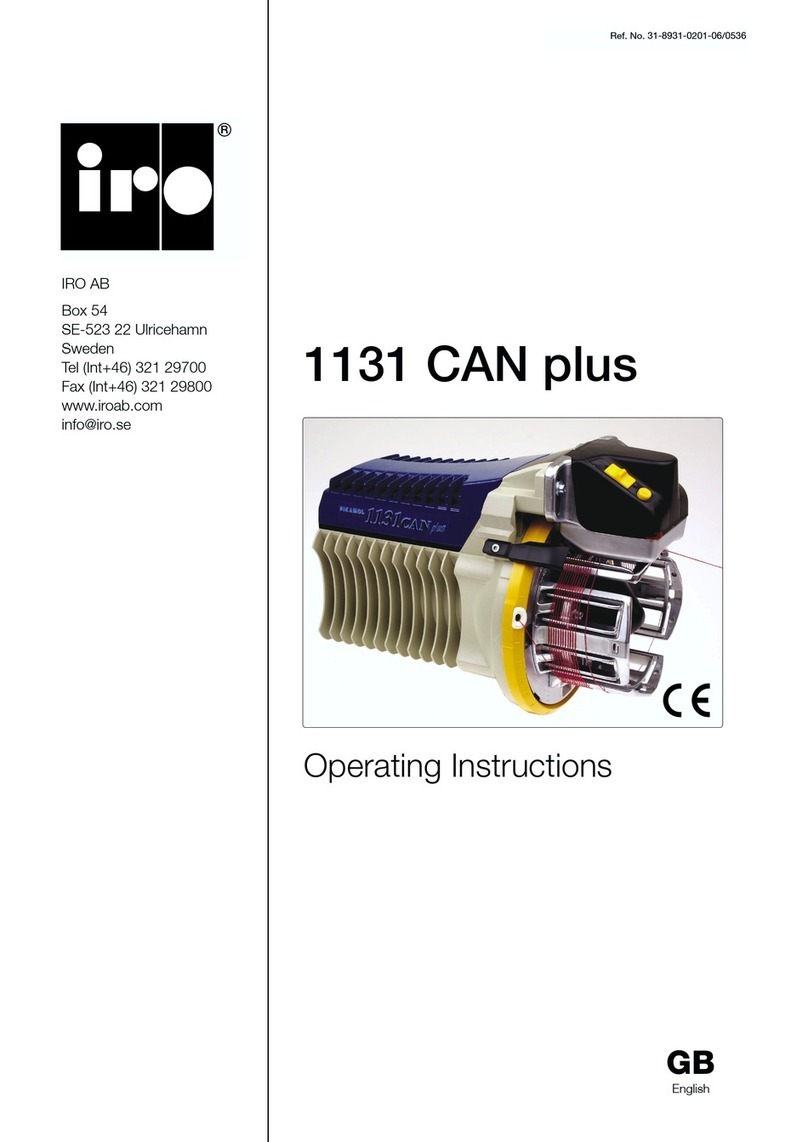Mankenberg VV Series Installation instructions

Original operating manual
Vacuum breaker
Originalbetriebsanleitung
Vakuumbrecher
VV
VV-4.X.22.3 Stand 07.11.2022 www.mankenberg.com

2
VV-4.X.22.3 Stand 07.11.2022 www.mankenberg.com
Table of contents EN
1 Introduction................................................................................................................................................. 4
2 Intended use ............................................................................................................................................... 4
3 Marking of the fitting.................................................................................................................................. 5
4 Safety instructions ..................................................................................................................................... 6
4.1 General precaution .............................................................................................................................. 6
4.2 Special safety instructions for the plant operator................................................................................. 6
4.3 Special hazards ................................................................................................................................... 6
5 Transport and storage ............................................................................................................................... 7
6 Installation................................................................................................................................................... 8
6.1 General notes ...................................................................................................................................... 8
6.2 Installation preparations....................................................................................................................... 9
6.3 Installation steps .................................................................................................................................. 9
7 Pressure testing the pipeline section....................................................................................................... 11
8 Initial start-up.............................................................................................................................................. 11
9 Normal operation........................................................................................................................................ 12
10 Maintenance................................................................................................................................................ 13
11 Troubleshooting help................................................................................................................................. 14
12 Information on REACH and RoHS ............................................................................................................ 16
12.1 Declaration on the REACH Regulation 1907/2006.............................................................................. 16
12.2 Declaration on the RoHS Directive 2011/65/EU .................................................................................. 16
13 Further information .................................................................................................................................... 16
14 Know How Vacuum Valves........................................................................................................................ 16
14.1 Function ............................................................................................................................................... 16
14.2 Vacuum control valves......................................................................................................................... 16
14.3 Vacuum breakers................................................................................................................................. 16
14.4 Operation ............................................................................................................................................. 16
14.5 Selecting valve type and nominal diameter ........................................................................................ 16
14.6 Vacuum breaker capacity table ........................................................................................................... 16
14.7 Protecting your system ....................................................................................................................... 17
14.8 Protecting the vacuum breaker............................................................................................................ 17
14.9 Setting the valve .................................................................................................................................. 17
14.10 Maintenance ........................................................................................................................................ 17
14.11 Valves free of oil and grease or silicone.............................................................................................. 17

Inhaltsverzeichnis DE
1 Einleitung .................................................................................................................................................... 18
2 Bestimmungsgemäße Verwendung.......................................................................................................... 18
3 Kennzeichnung der Armatur ..................................................................................................................... 19
4 Sicherheitshinweise................................................................................................................................... 20
4.1 Allgemeiner Sicherheitshinweis ........................................................................................................... 20
4.2 Spezielle Sicherheitshinweise für den Betreiber.................................................................................. 20
4.3 Besondere Gefahren ........................................................................................................................... 20
5 Transport und Lagerung............................................................................................................................ 21
6 Einbau.......................................................................................................................................................... 22
6.1 Allgemeines ......................................................................................................................................... 22
6.2 Vorbereitung zum Einbau .................................................................................................................... 23
6.3 Schritte beim Einbau............................................................................................................................ 23
7 Druckprüfung des Rohrleitungsabschnitts ............................................................................................. 25
8 Erste Inbetriebnahme................................................................................................................................. 25
9 Normalbetrieb ............................................................................................................................................. 26
10 Wartung....................................................................................................................................................... 27
11 Hilfe bei Störungen..................................................................................................................................... 28
12 REACH- und RoHS-Auskunft .................................................................................................................... 30
12.1 Erklärung zur REACH-Verordnung 1907/2006.................................................................................... 30
12.2 Erklärung zur RoHS-Richtlinie 2011/65/EU ......................................................................................... 30
13 Weitere Informationen................................................................................................................................ 30
14 Know-How .................................................................................................................................................. 30
14.1 Funktion ............................................................................................................................................... 30
14.2 Vakuumregelventile ............................................................................................................................. 30
14.3 Vakkumbrecher.................................................................................................................................... 30
14.4 Arbeitsweise ........................................................................................................................................ 30
14.5 Auswahl von Ventiltyp und Nennweite................................................................................................. 30
14.6 Durchsatztabelle für Vakuumbrecher .................................................................................................. 30
14.7 Absicherung Ihres Systems ................................................................................................................. 31
14.8 Schutz des Vakuumbrechers............................................................................................................... 31
14.9 Einstellung ........................................................................................................................................... 31
14.10 Wartung ............................................................................................................................................... 31
14.11 Öl- und fett- bzw. silikonfreie Geräte ................................................................................................... 31
3
VV-4.X.22.3 Stand 07.11.2022 www.mankenberg.com

Original operating manual
Vacuum breaker VV
4
VV-4.X.22.3 Issue 07.11.2022 www.mankenberg.com
1 Introduction
This manual is intended to assist users of a MANKENBERG vacuum breaker during installation, operation and
maintenance. Read the manual thoroughly before installing or putting this valve into service.
caution
Failure to follow the following instructions – particularly the cautionary and warning
notes – may lead to hazards and may invalidate the manufacturer's warranty.
MANKENBERG is at your servíce for any assistance and queries. See section Further
information [}16] for the addresses.
Technical information is also available at www.mankenberg.de
2 Intended use
A MANKENBERG vacuum breaker VV is a device only designed for protecting vessels or pipelines from
inadmissible underpressure (vacuum).
Is the internal pressure of a vessel decreasing by more than the preset differential pressure, the valve opens.
The system is vented until the preset differential pressure (towards the ambient pressure) is reached again.
Then the valve closes automatically closes.
note
The spring of a vacuum breaker is only slightly tensioned when delivered and not adjusted to a
defined opening pressure. It must be adjusted after installation. The pressure gauge needed
for the adjustment is not part of the supply schedule. A suitable vacuum indicator has to be
provided by the customer.
caution
A vacuum breaker does not protect the vessel from overpressure.
Therefore a suitable safety valve must be installed.
note
For very small differential pressures towards ambience or for precise vacuum control, the
installation of a MANKENBERG vacuum control valve is recommended.
MANKENBERG planning documents are available to give users precise assistance in selecting and designing
the appropriate fitting, e.g.:
In the section
<VV: Pressure control valves>:
<Know how vacuum valves>
<Data sheets VV34/36> with technical data and tables of the dimensions.
Admissible operating data are permanently marked on each device.
MANKENBERG valves are supplied as standard for screw-mounted or flange-mounted pipeline/tank
connections – also for special connections if required.
The upper limit of the permitted operating data for pressure and temperature is permanently marked on each
fitting supplied.

Original operating manual
Vacuum breaker VV
5
VV-4.X.22.3 Issue 07.11.2022 www.mankenberg.com
caution
These valves are no shut-off elements ensuring a tight closing of the valve. In accordance with
DIN EN 60534-4 and/or ANSI FCI 70-2 they may feature a leakage rate in closed position in
compliance with the leakage classes IV (0,01 % Kvs value).
caution
The standard version of the vacuum breakers is no equipment part with safety function in
accordance with the Pressure Equipment Directive. Otherwise this fact would be taken into
account in the Declaration of Conformity.
note
More than N=1000 alternating pressure loads from 0 bar up to PN (nominal pressure stage)
and/or from 0 bar up to PS (max. admissible outlet pressure) are not permitted.
The range of any number of pressure oscillations must not exceed 10% of the corresponding
PN (nominal pressure step) and/or PS (max. admissible outlet pressure).
3 Marking of the fitting
Each fitting bears the following markings as a minimum:
For Marking Remark
Manufacturer MANKENBERG See section Further information [}16] for the
address
Fitting design vacuum breaker + type Design name as per accompanying MANKENBERG
data sheet
Nominal diameter e.g. DN or G and numerical
value
Numerical value for DN in [mm], for G in [inches]
Rated pressure PN or Class and numerical
value
Numerical value for PN in [bar], for Class in [lbs/
square inch] pressure data are displayed as
overpressure above the atmospheric pressure
Max. permitted
temp.
Temperature and numerical
value
Temperatures above 50 °C entail a reduced pressure
resistance. This must be considered for the
corresponding material in accordance with the DIN
EN 1092 standard
Body material e.g. CrNiMo steel CrNiMo steel = high-alloy austenitic steel
Flow direction Indicated by an arrow
The markings (in the case of fittings made of stainless steel, they are etched into the body or the flange) should
neither be covered nor painted over, so that the fitting remains identifiable.

Original operating manual
Vacuum breaker VV
6
VV-4.X.22.3 Issue 07.11.2022 www.mankenberg.com
4 Safety instructions
4.1 General precaution
The same safety regulations apply to a fitting as to the system into which it is installed. These instructions only
give those safety recommendations that have to be additionally observed for the fitting.
4.2 Special safety instructions for the plant operator
The following requirements for the intended use of a fitting are not the responsibility of the manufacturer but
have to be guaranteed by the user.
» The fitting may only be employed for the purpose described in section Intended use [}4].
» Only competent specialist personnel may install, operate and service the fitting. Competent as defined in
these instructions refers to persons who, because of their training, specialist knowledge and professional
experience, are capable of correctly assessing and properly executing the work with which they are
entrusted and of recognizing and rectifying hazards.
» The pipeline system must be properly designed and installed so that the fitting can be mounted and
operated without any tension.
» The fitting must be properly installed in the correct mounting position.
» A vacuum breaker valve with an open spring must be installed in such a way that it presents no risk of
crushing to the operating personnel.
» The usual flow rates should not be exceeded in the pipeline section during continuous operation, and
abnormal operating conditions such as vibrations, water shocks and cavitation should be avoided or – if
unavoidable – clarified with the manufacturer in advance.
» The prevailing operating conditions must comply with the limits of the design data stated in the
MANKENBERG order confirmation.
» Dust and dirt from the surroundings could contaminate internal functional parts of the fitting or the medium.
» The corrosion protection for the fitting must be adapted to the local conditions.
» The fitting must not be coated with thermal insulation.
Detailed notes are provided on some of these prerequisites in the following sections.
4.3 Special hazards
danger of
fatalities
It is necessary to ensure on site, by an appropriate installation or by providing safety devices
and/or positioning a clearly visible warning sign in accordance with the regulations of EN 292
(formerly accident prevention regulations), that effective protection is afforded against objects
catching on an exposed spring in the vacuum breaker.
If required, MANKENBERG will assist in selecting a suitable type with closed bonnet.
Failure to observe this regulation may mean danger to life and limb.
danger of
being
crushed
Before a fitting is removed from the system or before a fitting is dismantled but partially
remains in place, the pressure in the system on both the inlet and outlet side must be
completely reduced so that there is no uncontrolled flow of the medium out of the system.
In the case of toxic or hazardous media, the system must be completely drained before the
fitting is removed.
Caution is required with residues that might continue flowing.

Original operating manual
Vacuum breaker VV
7
VV-4.X.22.3 Issue 07.11.2022 www.mankenberg.com
caution
If a fitting is removed from a system with a toxic medium and is taken out of the plant:
It must be properly decontaminated before repair.
5 Transport and storage
A fitting must be handled, transported and stored with care:
» The fitting must be transported and stored in its protective packaging until it is installed.
note
The fitting has moving internal parts.
Even packaged fittings should be transported smoothly without any shocks.
caution
In the case of a fitting that can no longer be transported by hand, the lifting gear must be
attached to a suitable position on the housing (branches).
Under no circumstances may the lifting gear be affixed to any attachments.
» When the fitting is stored prior to installation, it should be kept in closed rooms and protected against
harmful influences such as dirt, moisture and frost.
» In special cases, the fitting is supplied free of oil, grease or silicone and is marked accordingly. A fitting such
as this must not come into contact with oil/grease/silicone during storage and handling (particularly when
subsequently unpacked).
» A MANKENBERG fitting generally has functional or sealing parts made of elastomeric materials. These
cannot be stored for an unlimited period.
note
ISO 2230 describes the storage conditions for elastomers in detail and specifies the
permissible storage period.
Functional and sealing parts must be replaced well before the storage period expires.
They are available from MANKENBERG as a “service set”. See also section Troubleshooting
help [}14].
note
MANKENBERG fittings of small and medium nominal diameters are largely made of stainless
steel (high-alloy CrNiMo steel).
If, under exceptional circumstances, fittings are stored in a unpacked state, they must be
protected against ferritic dust to avoid corrosion.
note
The fitting is generally not capable of standing alone:
Handle with care so that the fitting does not tip over during transport/storage..

Original operating manual
Vacuum breaker VV
8
VV-4.X.22.3 Issue 07.11.2022 www.mankenberg.com
6 Installation
6.1 General notes
The same installation regulations apply to a fitting as to the system into which it is installed. The following
additional notes apply:
» Section Transport and storage [}7] should also be observed during transport to the installation site.
» The installation site to allow perfect functioning of a fitting should be a section of pipe without any flow
disruptions, without any angles and without any restrictors or shut-off devices close to the fitting, either
upstream or downstream (optimum distance = 10 x DN). If this does not apply, the installation situation
should be checked with the plant operator and/or MANKENBERG.
» The statics of the pipeline must be designed so as to take account of the weight of the fitting – particularly
those with an eccentric mass. If required, the pipeline may have to be properly supported on both sides next
to the fitting (or at the fitting itself) – particularly in the case of fittings with a substantial mass and especially
if vibrations are to be expected in the system.
» When the fitting is supported, it is important to check that all functioning parts (adjusting screws, springs)
remain capable of moving freely and are not blocked.
caution
As the fitting is open towards atmosphere, it must be adequately protected against dust and
atmospheric conditions.
» The fitting must not be coated with thermal insulation.
caution
A fitting that is operated at a medium temperature above 130°C needs undisrupted removal of
heat if it is to function perfectly.
Failure to observe this instruction may cause damage to the fitting and hence in the
pipeline system as well.
» A vacuum breaker with an exposed spring must be installed in such a way that it does not presents a risk of
crushing.
danger of
being
crushed
It is necessary to ensure on site, by an appropriate installation or by providing safety devices
and/or positioning a clearly visible warning sign in accordance with the regulations of EN 292
(formerly accident prevention regulations), that effective protection is afforded against objects
catching on an exposed spring in the vacuum breaker.
If required, MANKENBERG will assist in selecting a suitable type with closed bonnet.
Failure to observe this regulation may mean danger to life and limb.

Original operating manual
Vacuum breaker VV
9
VV-4.X.22.3 Issue 07.11.2022 www.mankenberg.com
6.2 Installation preparations
» It is necessary to ensure that a fitting is not installed unless its matches the operating conditions in terms of
function, pressure and temperature, range, body material as well as connection type and dimensions.
danger of
fatalities
No fitting may be operated that does not have a sufficient pressure and temperature range for
the operating conditions – see section Intended use [}4] and markings on the fitting.
The manufacturer MANKENBERG should be consulted in the case of any applications outside
of this range.
Failure to observe this regulation may mean danger to life and limb and may cause
damage to the pipeline system.
» A vacuum breaker that is not preset must be adjusted during initial start-up by setting the adjusting screws
of the spring – see section Initial start-up [}11]. Make sure that during installation there is enough room for
the appropriate wrench and screw driver above the adjusting screw and beneath the valve.
» Newly installed tanks and pipeline sections must be thoroughly rinsed and cleaned before commissioning.
» The corrosion protection for the fitting must be adapted to the local conditions.
important
note
As a general rule, vacuum breakers (with exposed spring or with bonnet) must be installed in
a way that the spring points vertically up.
note
Dust and dirt from the surroundings could contaminate internal functional parts of the fitting or
the medium. As the intake must be left open to the atmosphere it must be adequately
protected against entering of foreign substance by the customer.
6.3 Installation steps
» Fittings should only be finally unpacked at the installation site and inspected for damage prior to assembly.
Damaged fittings must not be installed.
» It is necessary to ensure that the covers have been removed from all the connection branches before
installation.
» The fitting should be inspected to ensure that it is clean. Interior parts must be free of liquid (e.g.
condensate): if necessary, connecting branches should be cleaned before installation with clean
compressed air.
» The type and dimensions of the line or tank connections must match the fitting to be installed and be flush
with the connecting surfaces of the fitting as well as in a parallel plane to the fitting itself.
» If the fitting is marked with an arrow on the housing, the flow in the pipe section must match the marked
direction of flow.
caution
If installed in the opposite direction to the arrow, the fitting will not perform its intended
function.
» The fitting must be installed without any tension..

Original operating manual
Vacuum breaker VV
10
VV-4.X.22.3 Issue 07.11.2022 www.mankenberg.com
note
It is necessary to ensure that even under operating conditions no tension from the pipeline
is transferred to the fitting.
note
A MANKENBERG fitting made of "high grade" or "high grade pure" stainless steel (austenite,
e.g. 1.4404 or 1.4435) does not need any surface protection for normal environmental
atmosphere and for normal weather conditions.
External parts of the fitting made of low-alloy or non-alloy materials that are supplied ex-works
with a primer have to be provided with a suitable coating by the customer.
Caution: never paint over the marking(s) of the fitting (either etched into the body or on
nameplate).
In addition, the following applies to the pipeline connection:
with flanges:
note
The sealing surfaces on the body of the fitting are formed in accordance with the
MANKENBERG order confirmation. The accompanying flange seals are generally not
included in the MANKENBERG supply schedule.
During installation, centre the fitting by means of the flange screws on the mating flange before the screws are
tightened.
with screw-mountings:
note
The connecting surfaces on the body of the fitting are formed in accordance with the
MANKENBERG order confirmation. The required seals are generally not included in the
MANKENBERG supply schedule.

Original operating manual
Vacuum breaker VV
11
VV-4.X.22.3 Issue 07.11.2022 www.mankenberg.com
7 Pressure testing the pipeline section
The fitting has already been pressure-tested by the manufacturer. The following points should be observed
when conducting a pressure test on a pipeline section with a pressure-regulating valve installed:
According to EN 12266-1, the test pressure may under no circumstances exceed 1.5 times the value
indicated on the body with “PN” or “Class”.
If any leakage occurs on the fitting, section Troubleshooting help [}14] should be observed.
note
If the pipe section is flushed and/or dried after assembly or pressure testing, it is necessary to
make sure that the fitting has not been damaged by corrosion or excessively high temperature.
8 Initial start-up
The vacuum breaker is supplied with no tension on the spring – hence no defined operating pressure has been
set in the factory. The valve must be adjusted during initial start-up.
Tension the spring with the adjusting screw:
Clockwise rotation (when looking onto the adjusting screw) has the following effect:
» The differential pressure (between atmospheric and internal pressure) for the valve opening increases.
note:
The adjustment of the vacuum breakers VV 34 is done with the scale on the bonnet. This scale indicates the
differential pressure between atmospheric and internal pressure. Vacuum breakers VV 36 have no scale and
are adjusted in the factory.
Exactness of the Scale:
DN 20 up to DN 40 (seat ø 12 up to 25 mm) ± 0,15 bar
DN 50 up to DN 100 (seat ø 32 up to 65 mm) ± 0,10 bar
This set value must be controlled by evacuating the system.
The setting of the vacuum breaker VV36 can exclusively be controlled if the system is under vacuum
correspondingly.
caution
When looking onto the adjusting screw:
Do not violently screw the adjusting screw against the limit stop (by rotating
anticlockwise).
danger of
fatalities
No fitting may be operated that does not have a sufficient pressure and temperature range for
the operating conditions – see section Intended use [}4] and markings on the fitting. The
manufacturer MANKENBERG should be consulted in the case of any applications outside of
this range.
Failure to observe this regulation may mean danger to life and limb and may cause
damage to the pipeline system.
note
At the beginning of initial start-up any intake protection - if installed by the customer – has to
be cleaned to avoid constipation.
Observe the corresponding notes in section Installation preparations [}9] .

Original operating manual
Vacuum breaker VV
12
VV-4.X.22.3 Issue 07.11.2022 www.mankenberg.com
caution
Installation preparations
Check the seals on screw-mounted parts of the body and reseal if necessary. If required, ask
MANKENBERG for the tightening torques.
Observe the relevant notes in Section Troubleshooting help [}14] .
The flow rate specified in the data sheet and the article texts refer to the fully open valve. To achieve these flow
rates the scale setting of the response pressures ∆P for type 34 must be set 0.05 bar lower than the tabular
values. The reason for this is the spring force (spring rate) that increases with rising performance and cone lift.
9 Normal operation
A properly designed vacuum breaker works automatically and does not need any form of auxiliary energy.
danger of
fatalities
It is necessary to ensure that the materials selected for the parts of the fitting in contact with
media are suitable for the media in use. The manufacturer accepts no liability for any damage
due to corrosion by aggressive media on parts made of unsuitable materials.
Failure to observe this regulation may mean danger to life and limb and may cause
damage to the pipeline system and to the fitting.
caution
The fitting has functional parts that have to remain capable of moving easily. Make sure that
parts in contact with the medium cannot freeze nor become blocked by dirt or deposits.
Observe the maintenance intervals.
Failure to observe this instruction may cause damage to the pipeline system and to the
fitting.
It is recommended that the fitting should be inspected to ensure that it is functioning correctly after each new
start-up.

Original operating manual
Vacuum breaker VV
13
VV-4.X.22.3 Issue 07.11.2022 www.mankenberg.com
10 Maintenance
The automatic function of the fitting requires maintenance to ensure that it continues to operate perfectly. It is
important for maintenance work to take place in a planned manner at periodic intervals.
The maintenance plan is a recommendation by the manufacturer MANKENBERG, which should be
supplemented by practical experience gained by the user under the prevailing operating conditions.
MANKENBERG shall assume no liability resulting from improper maintenance and/or repairs.
Sample plan for maintenance work
Type of maintenance Work to be performed Period 1)
Check function Check whether function is fulfilled as per section Intended use [}4] at least 1x
per week
with soft packing
(VV 34, VV36):
actuate taper spindle
mechanically
The soft packing tends to sticking to the seat.
Make valve pressureless and release spring.
Press taper spindle down (done with a screw driver through the
lateral borehole at VV 34)
at least 1x
per week
Check seals on the
body and the pipe
connection
Visual inspection at least 1x
per month
Monitor open bonnet Visual inspection:
if necessary, remove any dirt/corrosion 2)
at least 2x
per year
If installed upstream
of the fitting:
clean strainer
According to the manufacturer's instructions Depends on
the
contaminati
on of the
medium
Preventive
maintenance Dismantle fitting, see Section Troubleshooting help [}14].
Sichtkontrolle und Funktionsteile
Alle Teile des Wartungssatzes ersetzen 3)
at least 1x
per year
1) See comment at the beginning of this section: The time intervals are guides which should be adapted to
match the prevailing operating conditions, the properties of the medium in the system and the user's
experience.
2) Caution danger of crushing: shut down the valve for cleaning purposes!
3) Request maintenance set and replacement instructions from MANKENBERG.
danger
During maintenance work (apart from visual inspections) the relevant recommendations and
warning notes in section Troubleshooting help [}14] should be observed.
Failure to observe this warning may mean danger to life and limb and may cause
damage to the pipeline system and to the fitting.
When a fitting that has previously been dismantled is being put back into service, the fitting should be checked
for proper sealing capacity and function as well as correct adjustment of the adjusting and functional
components!

Original operating manual
Vacuum breaker VV
14
VV-4.X.22.3 Issue 07.11.2022 www.mankenberg.com
11 Troubleshooting help
Be sure to observe section Safety instructions [}6] when rectifying faults.
Spare parts must be ordered with all the details on the nameplate. Only original parts from the manufacturer
MANKENBERG may be installed.
MANKENBERG experts are available to help in rectifying faults as quickly as possible. See section Further
information [}16] for the addresses.
note
If functional or corrosion damage is detected during maintenance or after a fault:
consult MANKENBERG to find out whether a more suitable fitting is available or whether the
damaged part can be supplied in a better-suited material.
Type of fault Action
Leakage at a
connection body parts
(flange, threaded pin or
clamp ring):
reseal connection
Retighten housing/flange connection and clamp ring screws (clockwise)
danger of fatalities
To prevent any risk for operating personnel, make sure that this repair measure is
only carried out when the pipeline section is not under pressu- re. Take note of
section Special hazards [}6] and then section Installation [}8].
Functional fault
leakage at the seat
clean functional parts
Cut off system immediately and/or remove pressure.
A foreign object may be jammed in the seat and be preventing proper sealing:
Slacken spring: Rotate adjusting screw anticlockwise (viewed from above) so that
the vacuum breaker can open:
the foreign body should be flushed away.
If the functional fault cannot be rectified in this way:
The vacuum breaker must be disassembled and cleaned.
danger of fatalities
To prevent any risk for operating personnel, make sure that this repair measure is
only carried out on a system that is not under pressure. Take note of section
Special hazards [}6].
When the vessel is pressureless, dismount the vacuum breaker and disassemble
and clean the functional parts. Here all parts of the maintenance set should be
renewed. Then reassemble the readjust fitting. When reinstalling, regard Section
Installation [}8] and readjust as described in section Initial start-up [}11].

Original operating manual
Vacuum breaker VV
15
VV-4.X.22.3 Issue 07.11.2022 www.mankenberg.com
Type of fault Action
Functional fault
cleaning alone – see
above – cannot rectify
the fault:
The fitting must be
repaired
If during cleaning it is found that the cone or other functional parts are damaged:
Repair necessary: damaged parts have to be replaced.
If the repair is to be carried out in the customer's workshop:
make a note of all data according to the markings on the fitting and order the
spare parts and necessary instructions from MANKENBERG. See section Further
information [}16] for addresses.
or:
Send the fitting to the manufacturer for repair. See section Further information
[}16] for the addresses.

Original operating manual
Vacuum breaker VV
16
VV-4.X.22.3 Issue 07.11.2022 www.mankenberg.com
12 Information on REACH and RoHS
12.1 Declaration on the REACH Regulation 1907/2006
The Mankenberg product provided may contain candidate substances (SVHC) a candidate substance (SVHC)
in a concentration of less than 0,1 % (w/w) according to the Candidate List (REACH Regulation, Article 33); as
per January 2021.
12.2 Declaration on the RoHS Directive 2011/65/EU
Mankenberg products are not electrical or electronic equipment and therefore do not fall within the scope of
RoHS Directive 2011/65/EU (RoHS 2, Article 4, paragraph 1 or Annex I).
13 Further information
You can obtain these instructions, the MANKENBERG data sheets quoted as well as further information –
including English language versions – from the following addresses:
Mankenberg GmbH
Spenglerstrasse 99
D-23556 Lübeck
Phone +49-451 -8 79 75 0
Fax +49-451 -8 79 75 99
E-Mail [email protected]
www.mankenberg.de
14 Know How Vacuum Valves
14.1 Function
Vacuum breakers protect vessels and pipelines against vacuum. A vacuum can build up when a system is being
drained, when it cools down or when a pump fails. Vacuum control valves are pressure reducing or overflow
valves which control pressures below 1 bara.
14.2 Vacuum control valves
See Kow How pressure reducing valves and overflow valves.
14.3 Vacuum breakers
14.4 Operation
Vacuum breakers protect installations, vessels etc. against vacuum. They are normally closed. If the pressure
inside a tank or vessel drops below atmospheric pressure by more than the set differential pressure, the valve
opens causing the system to be vented until the set pressure difference has been established again. Vacuum
breakers remain closed when the pressure rises above atmospheric; therefore they do not offer protection
against excessive pressure.
14.5 Selecting valve type and nominal diameter
Vacuum breakers should be selected according to the pressure difference between the atmospheric pressure
and the pressure inside the vessel or pipeline, not according to the vacuum or absolute pressure in the vessel or
pipeline. All specifications given in data sheets or tables or on the scales of valves etc., relate to this differential
pressure. Another factor which must be taken into account when selecting a vacuum valve is the suction
capacity. For very small differential pressures vacuum control valves can be used as vacuum breakers.
14.6 Vacuum breaker capacity table
Please use the capacity table to select your vacuum breaker. The table applies to valve types 34 and 36. On the
left side you will find the nominal diameter; at the top (horizontally) you find the differential pressure given in bar
at which the valve opens.

Original operating manual
Vacuum breaker VV
17
VV-4.X.22.3 Issue 07.11.2022 www.mankenberg.com
14.7 Protecting your system
If toxic or hazardous media are used measures must be taken to ensure that in the case of cone failure the
hazardous medium can be drained in a controlled and safe manner. In such a case we reccomend our type 33
with closed valve body and spring cap.
14.8 Protecting the vacuum breaker
Being open to atmosphere, the air intake ports must be sufficiently protected from dust, water, dirt, small
animals as well as weather effects. If there is a danger of freezing the vacuum breaker should by fitted with a
heating-jacket.
14.9 Setting the valve
The performance curves shown in the flow capacity diagram relate to fully open valves. To obtain these values
under partial load conditions, the operating pressures on the scales of valve types 34 and 35 should always be
set 0.05 bar below the pressures given in the diagram. The reason for this is the spring force which increases as
the flow and cone movement increase.
14.10 Maintenance
Vacuum breakers should be cleaned and serviced regularly. Depending on the ambient operating conditions,
the valve spindle should regularly be checked for freedom of movement. The service intervals should be
specified in a maintenance schedule.
14.11 Valves free of oil and grease or silicone
Please pay attention to order and fit only spares free of oil and grease resp. free of silicone.

Originalbetriebsanleitung
Vakuumbrecher VV
18
VV-4.X.22.3 Stand 07.11.2022 www.mankenberg.com
1 Einleitung
Diese Anleitung soll den Anwender eines MANKENBERG-Vakuumbrechers bei Einbau, Betrieb und Wartung
unterstützen. Lesen Sie diese Anleitung komplett durch, bevor Sie diese Armatur einbauen oder in Betrieb
nehmen.
Achtung
Wenn die nachfolgende Anleitung – insbesondere die Achtungs- und Warnvermerke –
nicht befolgt wird, könnten daraus Gefahren entstehen
und die Gewährleistung des Herstellers unwirksam werden.
Für technische Hilfestellung und Rückfragen steht MANKENBERG zur Verfügung. Adressen
siehe Abschnitt Weitere Informationen [}30]
Technische Informationen auch unter www.mankenberg.com
2 Bestimmungsgemäße Verwendung
Ein MANKENBERG Vakuumbrecher VV ist ausschließlich dazu bestimmt, einen Behälter oder eine
Rohrleitung vor unzulässigem Unterdruck (Vakuum) zu schützen:
Sinkt der Behälterinnendruck um mehr als den eingestellten Differenzdruck, öffnet das Ventil. Das System wird
so lange belüftet, bis der eingestellte Differenzdruck (zur Umgebung) wieder erreicht ist. Danach schließt das
Ventil sofort wieder selbsttätig.
Hinweis
Die Feder eines Vakuumbrechers ist im Anlieferungszustand in der Regel nur schwach
gespannt, aber nicht auf einen definierten Ansprechdruck eingestellt.
Sie muss nach Einbau eingestellt werden. Das dazu benötigte Manometer ist nicht Teil des
Lieferumfangs. Dafür ist anlagenseitig ein passendes Vakuum-Anzeigegerät erforderlich.
Achtung
Ein Vakuumbrecher schützt den Behälter nicht vor Überdruck.
Dafür muss ein passendes Sicherheitsventil eingebaut werden.
Hinweis
Für sehr geringe Differenzdrücke zur Atmosphäre oder für feinere Vakuumregelung empfiehlt
sich der Einsatz eines MANKENBERG-Vakuumregelventils.
Für die Auswahl und Auslegung der passenden Armatur geben MANKENBERG-Planungsunterlagen dem
Anwender präzise Hilfestellung, z.B.:
Im Abschnitt
<VV: Regelarmaturen für Druck>:
<Know-How Vakuumventile>
<Datenblätter VV34/36> mit technischen Daten und Tabellen der Abmessungen.
Zulässige Betriebsdaten sind außerdem auf jedem einzelnen Gerät dauerhaft gekennzeichnet.
MANKENBERG-Armaturen werden standardmäßig für verschraubte oder geflanschte Rohrleitungs-/
Behälteranschlüsse geliefert – auf Wunsch auch für Sonderanschlüsse.
Die obere Grenze der zulässigen Betriebsdaten Druck und Temperatur ist auf jeder gelieferten Armatur
dauerhaft gekennzeichnet.

Originalbetriebsanleitung
Vakuumbrecher VV
19
VV-4.X.22.3 Stand 07.11.2022 www.mankenberg.com
Achtung
Vakuumbrecher sind keine Absperrorgane, die einen dichten Ventilabschluss gewährleisten.
Sie können in der Schließstellung nach DIN EN 60534-4 und/oder ANSI FCI 70-2 eine
Leckrate entsprechend der Leckageklasse IV (0,01 % Kvs-Wert) aufweisen.
Achtung
Vakuumbrecher sind in der Standardausführung keine Ausrüstungsteile mit
Sicherheitsfunktionen nach Druckgeräterichtlinie. Andernfalls wird dies in der
Konformitätserklärung berücksichtigt.
Hinweis
Mehr als N=1000 Druckwechselbelastungen von 0 bar bis PN (nominale Nenndruckstufe) bzw.
von 0 bar bis PS (maximal zulässiger Hinterdruck) sind nicht zulässig.
Die Druckspanne beliebig vieler Druckschwankungen darf 10% vom jeweiligen PN (nominale
Nenndruckstufe) bzw. PS (maximal zulässiger Hinterdruck) nicht überschreiten.
3 Kennzeichnung der Armatur
Jede Armatur trägt mindestens die folgenden Kennzeichnungen:
Für Kennzeichnung Bemerkung
Hersteller MANKENBERG Adresse siehe Abschnitt Weitere Informationen
[}30]
Armaturenbauart Vakuumbrecher + Typ Bauartbezeichnung lt. zugehörigem MANKENBERG-
Datenblatt
Nennweite z.B. DN oder G und
Zahlenwert
Zahlenwert für DN in [mm], für G in [inch] (Zoll)
Nenndruck PN oder Class und
Zahlenwert
Zahlenwert für PN in [bar], für Class in [lbs/square
inch] Wenn nicht anders angegeben, geben alle
Angaben den Überdruck über dem
Atmosphärendruck an.
Max. zul. Temp Temperatur und Zahlenwert Temperaturen über 50 °C führen zu einer
Abschwächung der Druckfestigkeit. Diese ist
entsprechend der Norm DIN EN 1092 für den
jeweiligen Werkstoff zu berücksichtigen.
Gehäusematerial z.B. CrNiMo-Stahl CrNiMo-Stahl = hochlegierter austenitischer Stahl
Durchflussrichtung mit Pfeil gekennzeichnet
Die Kennzeichnungen (bei Armaturen aus Edelstahl am Gehäuse oder Flansch eingeätzt) sollen weder
abgedeckt noch überstrichen werden, damit die Armatur identifizierbar bleibt.

Originalbetriebsanleitung
Vakuumbrecher VV
20
VV-4.X.22.3 Stand 07.11.2022 www.mankenberg.com
4 Sicherheitshinweise
4.1 Allgemeiner Sicherheitshinweis
Für eine Armatur gelten dieselben Sicherheitsvorschriften wie für das System, in das sie eingebaut ist. Die
vorliegende Anleitung gibt nur solche Sicherheitshinweise, die für die Armatur zusätzlich zu beachten sind.
4.2 Spezielle Sicherheitshinweise für den Betreiber
Die folgenden Voraussetzungen für die bestimmungsgemäße Verwendung einer Armatur sind nicht in der
Verantwortung des Herstellers, sondern müssen vom Verwender sichergestellt werden:
» Die Armatur darf bestimmungsgemäß nur so verwendet werden, wie im Abschnitt Bestimmungsgemäße
Verwendung [}18] beschrieben ist.
» Nur sachkundiges Fachpersonal darf die Armatur einbauen, bedienen und warten. Sachkundig im Sinne
dieser Anleitung sind Personen, die aufgrund ihrer Ausbildung, Sachkenntnis und Berufserfahrung die ihnen
übertragenen Arbeiten richtig beurteilen, korrekt ausführen und mögliche Gefahren erkennen und beseitigen
können.
» Das Rohrleitungssystem muss fachgerecht so ausgelegt und verlegt sein, dass die Armatur spannungsfrei
montiert und betrieben werden kann.
» Die Armatur muss korrekt und in der richtigen Einbaulage eingebaut sein.
» Ein Vakuumbrecher mit einer offenliegenden Feder muss so installiert werden, dass keine Quetschgefahr
für das Bedienungspersonal besteht.
» Im Rohrleitungsabschnitt sollen die üblichen Durchflussgeschwindigkeiten im Dauerbetrieb nicht
überschritten werden und abnormale Betriebsbedingungen wie Schwingungen, Wasserschläge und
Kavitation vermieden werden oder – soweit nicht zu vermeiden – im Vorwege mit dem Hersteller abgeklärt
sein.
» Die herrschenden Betriebsbedingungen müssen den Grenzen der Auslegungsdaten, die in der
MANKENBERG-Auftragsbestätigung genannt sind, entsprechen.
» Staub und Schmutz aus der Umgebung müssen von den innenliegenden Funktionsteilen der Armatur
ferngehalten werden, damit sie das Medium nicht verschmutzen.
» Der Korrosionsschutz der Armatur muss den Umgebungsbedingungen vor Ort angepasst werden.
» Die Armatur darf nicht mit einer Wärmeisolierung umhüllt werden.
In den nachfolgenden Abschnitten sind zu einigen dieser Voraussetzungen detaillierte Hinweise gegeben.
4.3 Besondere Gefahren
Lebens-
gefahr
Es muss vor Ort sichergestellt sein, dass durch den passenden Einbau oder durch
entsprechende Schutzvorrichtungen und/oder durch einen deutlich sichtbaren Warnhinweis ein
wirksamer Schutz vor Einklemmen an einer offenliegenden Feder des Vakuumbrechers
gewährleistet ist.
Im Bedarfsfall hilft MANKENBERG bei der Auswahl einer passenden Armatur mit
geschlossener Federhaube.
Missachtung dieser Vorschrift kann Gefahr für Leib und Leben bedeuten.
Quetsch-
gefahr
Vor dem Ausbau einer Armatur aus dem System oder Zerlegen einer Armatur, die teilweise
dort verbleibt, muss der Druck im System vordruck- und hinterdruckseitig ganz abgebaut
sein, damit das Medium nicht unkontrolliert austritt.
Bei toxischen oder gefährlichen Medien muss das System vollständig entleert sein, bevor die
Armatur ausgebaut wird.
Vorsicht bei Rückständen, die nachfließen könnten.
This manual suits for next models
2
Table of contents
Languages:
Other Mankenberg Industrial Equipment manuals
